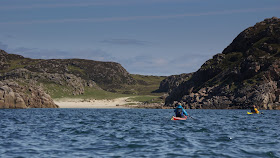We reconvened on the beach at Martyr's Bay after visiting Iona's abbey in order to finalise the route for the rest of the day. Our general plan was to head along the south coast of the Ross of Mull in order to paddle in relative shelter from the forecast northerly wind.
Once again we crossed the Sound of Iona, using the South Cardinal channel marker as an aiming point. The UK buoyage system conforms to the IALA (International Association of Lighthouse Authorities) Region A model, so a South Cardinal mark indicates that safe navigable water may be found to the south of the buoy. Although the depth isn't an issue for sea kayaks, we passed south of the mark anyway.....
...en route to the skerries to the west of Erraid.......
...and then south through Tinker's Hole to gain the south coast of the Ross of Mull.
Once again we resisted the temptation of several lovely little white sand beaches.....
...as our sights were set on the head of Balfour's Bay.....
...with the promise of a sheltered spot from the breeze, and a landing on white sand fringed with crystal clear water - it's a hard spot to pass by!
We intended to spend a leisurely hour at Balfour's Bay in order to enjoy the place properly. I wandered around exploring first the beach itself. The sand here is fine, clean silver white stuff, broken down from granite and glacial deposits. I collected a jar of it and found it amazingly clean and constant in grain size. The receding tide had etched ripples across a broad band of the beach, the lines of which seemed to continue into the fissured pink granite outcrops forming the arms of the bay.
Douglas and I have both frequently referred to "pink granite" in this series of posts - so it's time to take a closer look....
The granite which forms the Ross of Mull is about 414-420 million years old and was formed by the intrusion of a huge mass of silicic magma into the Moine rocks when they were still buried deeply during the Caledonian Orogeny (mountain building) period.
The total mass of the granite intrusion may be as much as 50 square kilometres, with about half of this below the current sea level and half of it exposed to form the Ross of Mull. Geologists describe it as "massive" and "coarse-grained" - the typical grain size is 2-5mm indicating that the rock cooled slowly within the Earth's crust. In technical terms it's a K-Feldspar (Potassium Feldspar) granite and the predominance of K-Feldspar over white Plagioclase (another type of Feldspar mineral) gives the characteristic pink colour. The dark crystals are a mix of biotite mica, smoky quartz and titanite.
The Ross of Mull granites typically form rounded outcrops but break naturally along joints in the rock which makes it convenient to quarry while its hard and consistent nature make it ideal for precisely dressed blocks. The Stevenson lighthouses at Hyskeir, Skerryvore and Dubh Artach are all constructed of Ross of Mull granite - and it's no coincidence that these are the probably the most exposed of the "sea lights". Other well known buildings to be constructed of granite from the Ross of Mull include Holborn Viaduct and Blackfriars Bridge in London, also the docks at Liverpool, Glasgow and even New York.
Under sunshine the granite is a striking warm pink and a great contrast to white sand and blue sea.....
...in fact we were so taken by the colours before us that we accompanied first luncheon with a small dram of Jura Superstition in order to toast the view......
....which was declared by unanimous verdict to be one of the very best!










No comments:
Post a Comment